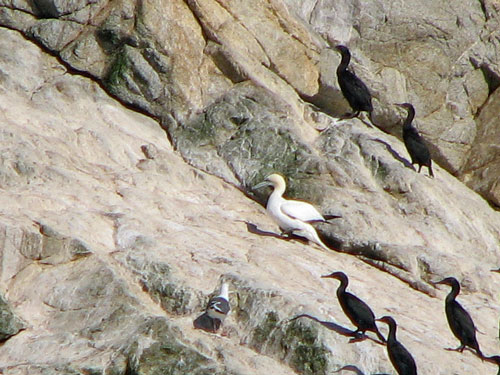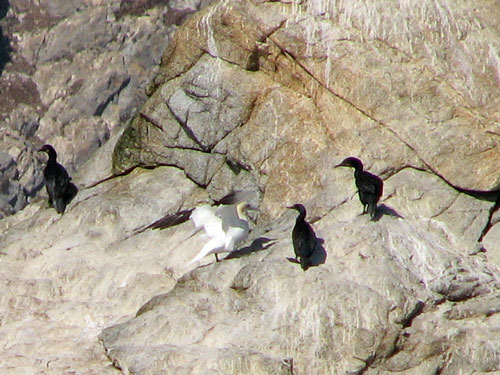Northern Gannet (Morus bassanus)
Saddle Rock, Southeast Farallon Island, San Francisco County CA
1 October 2012
Joseph Morlan
Photos © 1 October 2012 by Joseph Morlan. All rights reserved (Higher resolution images).

This was a chase trip for the long staying Northern Gannet which was first seen on the Farallons
25 April 2012 and which appears to be the first record of this species in the North Pacific. We took the New Captain
Pete out of Half Moon Bay which had been chartered by Alvaro Jaramillo. We reached the island about 2:30pm and
spent considerable time watching the gannet before heading back. At first the gannet was preening in the midst
of a group of Brandt's Cormorants (Phalacrocorax penicillatus) but as we approached the south side of Saddle
Rock, suddenly the ocean started to boil. All the gulls and most of the cormorants left the rock during the clamor
as the ocean turned blood red. The head of a doomed California Sea Lion could be seen for a few seconds and then
the fin and tail of a Great White Shark appeared to lunge at the Sea Lion. Then the ocean turned quiet again.
See photos by Todd Easterla.
During this extraordinary spectacle the gannet stayed on the rock, but looked intently at the action. After
it was over, the cormorants started to return to the rock, but a flock of gulls continued to hover over the area
of the shark attack, calling loudly.
Views of the gannet were mostly from a considerable distance, but apparently much closer than on previous chase
trips for this exceptional bird. I was able to get these images with my point and shoot Canon Powershot S3IS at
12X optical zoom. 
Description
The following description is based on memory and on photos:
A large white bird, plumper than nearby Brandt's Cormorants with a long cone-shaped bill and long pointed
white tail. The bill was gray with a slight bluish cast. The head was suffused with buff, but the rest of the plumage
was pure white except for the primaries which were black. I got one photo showing the spread wing (below) which
shows the secondaries are white thus eliminating both Cape and Australasian Gannets as well as Masked/Nazca and
Red-footed Booby. Furthermore, the chin was feathered which makes this a gannet and not a booby. The legs were
short and appeared dark gray.
From this distance it was difficult to make out details of the bill plating, but the eye could be seen to
be very close to the upper mandible and the gape appeared to come to a point behind and below the eye.
Discussion
This is clearly a full adult Northern Gannet. The BNA account is vague about the exact plumage sequences
stating "Plumage stages between Juvenal and Definitive not well understood; birds gradually (3-4 yr.) develop
all-white plumage at any one time." BNA also states that "Gannets remain at sea all year during their
first 3 yr...." As the Farallon bird keeps returning to the island and has been reported exhibiting courtship
display, it would seem that it is probably at least that old.
Although this is the first Northern Gannet in the North Pacific it is worth noting that a Northern Gannet was
seen by two people on separate research vessels within 24 hours of each other at sea off the coast of Barrow, Alaska
on August 16 and 17, 2010. No photographs were taken so the species was added to Alaska's "unsubstantiated"
list.
Outside Links
Alvaro Jaramillo's photos from this trip are here.
An essay with additional photos about this bird is on the Farallon
Blog. They speculate that the occurrence of this bird in the North Pacific could be a consequence of the breakup
of ice in the Arctic Ocean and the creation of a "Northwest Passage."

